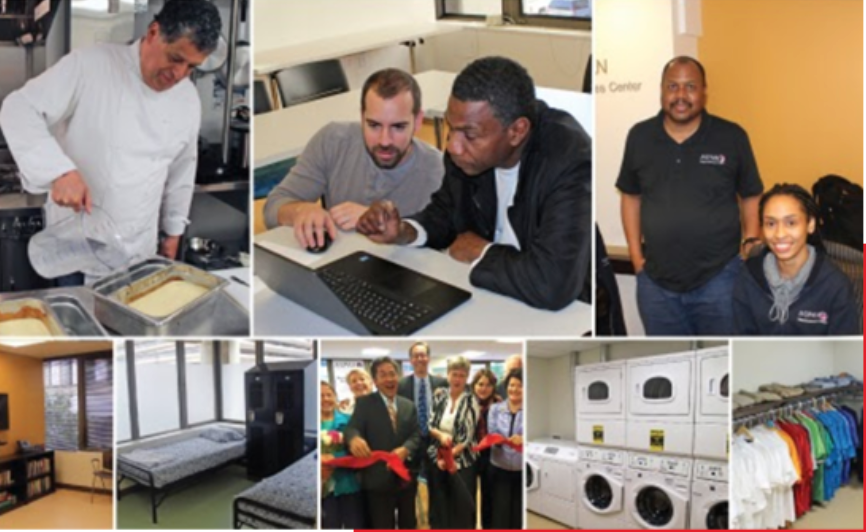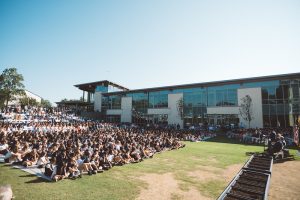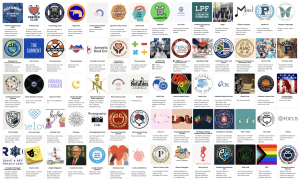Finding a Home for our Cafeteria Leftovers
An Interview with Mr. Stephen Champion of PathForward Virginia’s Shelter Program
A photo montage of some of the services offered by PathForward
November 21, 2022
It’s trendy to trace where your food comes from and to peer into the process that plopped it onto your plate. Is it organic, local, or free range? Did the cow have a good life? But how often do you think about where our food goes? I’m referring to the food that’s prepared for us by Meriwether Godsey, but left alone to grow cold in a chafing dish, unloved and uneaten. Do leftovers disappear into a netherworld that exists between your stomach and the trash?
Recently, I interviewed Mr. Wes Rosati, Potomac’s executive chef, to find out what happens to the cafeteria food that never hits students’ plates. Spoiler: most still-edible leftovers that are not repurposed in soups or salads are donated to Path Forward VA, a social services organization whose self-described mission is to transform lives by delivering housing solutions and pathways to stability.
I called up the non-profit to learn about our leftover lunches’ next stop on their post-Potomac journey. Mr. Stephen Champion, a shelter monitor at Path Forward who helps manage food distribution, talked to me about minimizing waste and maximizing human dignity and health in the distribution of food.
Editor’s note: The following transcript has been edited for length and, very slightly, for clarity. You can soon hear Mr. Champion’s own voice in an extended podcast version of this interview, on The Potomac Current’s online edition.
Arielle: My school, Potomac School, donates leftover cafeteria food to your organization. I’ve heard that the food gets distributed amongst vulnerable communities. Could you tell me about that process, and what kind of food is eligible for donation?
Mr. Champion: Sure. Food distribution to clients really happens around the clock. We have set times for breakfast, lunch and dinner. But of course, if anyone’s hungry, we’re not going to say, “No, we’re not going to give you food.” We can feed anywhere between roughly 50 to 100 clients per shift. So the food that you all donate really helps us out and really helps with hunger. You guys are awesome. Thank you so much.
What kind of donations can be served to recipients? Are there any specific requirements?
Cold cut sandwiches, peanut butter and jelly sandwiches. Sometimes we get hot food…People donate all types of things. Juices, water, dry cereal, oatmeal, they will donate snacks, like chips, pretzels, boxes of raisins, fruit fruit snacks, uncooked chicken that our chef cooks up. Cookies. You know, people can just about donate anything.
Wow, that’s a lot of food. Does anything that gets donated go to waste, or does it all get used?
Everything that gets donated gets used. Sometimes we even re-donate stuff. If there’s another shelter that needs donations, and we have a supply of it, we’ll re-donate it to them.
Can you talk a little bit about the importance of food security? Why is that so important, especially for people trying to find stable housing? Why is there such an emphasis on making sure vulnerable communities have access to healthy food?
Well, first of all, eating healthy is very important in our society. Without nutritious food, chronic diseases and things caused by poor diets can lead to types of illnesses. I think that access to nutritious food is important especially with our vulnerable population. We can afford to buy healthier foods that are good for our bodies, whereas they have to eat the food that’s given to them.
It’s making sure they eat a complete diet. And this teaches them, when they actually are in their places by themselves, what a complete, healthy meal is. So they’re not just out there, eating unhealthy foods as well.
Every year, my school holds something called “Sandwich Day,” where we make hundreds of sandwiches with deli turkey, deli ham and processed cheese. But recently, there has been reporting on extensive research linking ultra processed foods to cancer, hypertension, and obesity. I wonder whether this is appropriate. What are your thoughts on that?
What are my thoughts? Well, you know, I think that if something has been determined to be unhealthy, then you gotta just go with that. I’m not a scientist at all, but I do believe that we should be going for healthier foods. The things that are going to help us prolong our lives and contribute to a healthier lifestyle.
What you put into your body is really important, especially as you get older. You’re gonna need your body to help you out a lot as you get older. When you’re younger, you can kind of withstand some things. But I do believe that if research has proven that certain foods cause illness, we should really take that into consideration and look for alternatives that won’t harm our bodies.
What do you think are useful alternative options that schools hosting food drives could donate? What do food banks need the most?
How does your organization work to minimize food waste?
We minimize food waste because we accept anybody on the streets. Our organization is a little unique because we have clients that live here year round. This is their home, their residence. So we feed them, but we will also feed anybody off the streets. You don’t have to be a resident of this county, or of Virginia. If you’re just hungry off the streets, and you want a bag lunch, we’re gonna feed you.
Not only that, we redistribute food to make sure that other shelters can feed the populations that they serve, as well. So I think that’s how we make sure not to waste food.
My thoughts
My discussion with Mr. Champion was as insightful and honest as his cause is important. It was interesting to hear an on-the-ground perspective; Mr. Champion witnesses the immediate, individual-level impacts of access to healthy food. He emphasized the importance of only donating foods that are beneficial in the long term to recipients, and educating recipients on nutrition.
We are fortunate to exist in a community that sometimes takes access to fresh, healthy food for granted. We float terms like “food sovereignty” and “sustainable diets. Though policy makers and advocates for sustainability coined these terms to bring awareness to income and food inequities faced by as many as 1 in 3 people in the DMV, frontline interactions with the community tell the real story. Mr. Champion grounds his work in personal interactions. He utilizes the resources he has access to, acknowledging that while the food he distributes may not always be the most healthy or sustainable choice, immediate hunger is addressed. Without talking to those on the frontline, it’s easy to get lost in the jargon and emphasize things that more fortunate members of society have choices about: organic food, local fresh produce, healthy meal decisions. It’s easy to forget about basic needs, when we never have to think about where our next meal is coming from.
Speaking to Mr. Champion, I struggled to define “food security” in concrete terms; I’ve been familiar with the concept for years, but stumbled trying to center it in the real world scenario of Mr. Champion’s work. Similarly, my first experience working at FACETS, a local food distribution center was eye-opening, a jarring contextualization of what it truly means to be food insecure. Why? The food distribution system isn’t perfect. It is continually in flux, and highly dependent on supply, rather than demand. I volunteered at FACETS several times over the course of last summer. Each time, I saw families with children turned away with less food than they needed because they’d arrived early in line; I watched the excess food handed out to single individuals at the end of the day. I was reminded that even those in deepest need have preferences, pride, and priorities. I saw people elated at the sight of a fresh pepper, and people rejecting foods they don’t like. What if an individual prefers unhealthy food? Who are we to judge their choices? Yet it doesn’t feel right to feed vulnerable communities unhealthy food that we wouldn’t eat ourselves. How do we honor personal preference, while still taking into account the health consequences of the food we distribute?
Without ever stepping out of our daily routine, our comfort zone, it is easy to forget and get lost in the vocabulary of the food secure community: organic, non-GMO, free-range. At the food distribution center, I saw children under 10 collecting food for their families, people with physical and intellectual challenges navigating the noisy lines, people who arrived still in work uniforms, people shouldering new-born babies in cloth slings, and people asking why there were no milk cartons left for their infants. People in need are everywhere. We cannot dehumanize or make assumptions about them, but we can work to ensure that we all have access to fresh food that fuels our bodies for years to come.
Mr. Champion bridges the gap between our privileged bubble (one that can afford to squander food without thought) and those in our community who struggle to access consistent, healthy meals. He sets an inspiring example for those of us seeking food justice, but unsure of where to start. Mr. Champion devotes his life to feeding and serving the community. It would serve us well to check in with people on the frontline more often, to ground ourselves, and ensure our well-intended efforts truly serve those in need.






